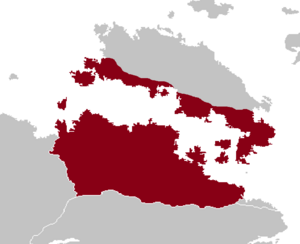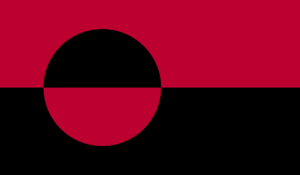Imperio Rojo
Imperio Rojo | |
|---|---|
| 1428–1754 | |
|
Flag | |
 The Empire in 1671 | |
| Capital | Nichero |
| Common languages | Condottiero |
| Government | Hereditary monarchy |
| History | |
• Established | 1428 |
• Overthrow of Cristoval VI | 15 March 1754 |
| Currency | Various |
The Imperio Rojo (literally Red Empire), known formally as the Empire of the House of Zifara, was a Knichan monarchy established in 1428 by Dominigo Zifara. At its peak the Empire ruled over all of Knichus and much of southern Lirinya while emerging as a regional naval and trading power. The Empire spent much of its existence in competition with the Caceritian Houses, Quenminese dynasties, and the Adamdar Empire for influence over eastern Siduri.
Knichus had been colonized extensively by the Sabrian Empire in the 1st Millennia BCE, leading to the settlement of many colonists from the Cacertian isles. This population later became known as the Condottiero, who persisted in habitation despite the conquest of the land by the Symmerian Empire. Following the withdrawal of the Symmerians following the Symmerian-Ridevan War, Knichus came under the influence of Rideva, only to then be partially conquered by the Kiếm Hoà Dynasty. Condottiero communities began forging closer ties with the Padova Empire to counter Quenminese influence, however the collapse of Cacerta into the Centuries War Period allowed for the ascension of local Condottiero rules, culminating in Dominigo Zifara establishing the House of Zifara in 1428 based out of the port city of Nichero. Bolstered by extensive usage of gunpowder (earning the moniker "gunpowder empire"), Zifara swiftly conquered most of Knichus and established a hereditary monarchy while laying the ground work for an extensive naval and mercantile presence in eastern Siduri.
The Empire spent much of its early history battling with Lirinya for control of the Soroko Strait. By the 16th Century the Empire had conquered much of the southern Lirinya coast; this success was followed by the Años abundantes ("Bountiful years") where the Empire enjoyed considerable growth and economic prosperity, in large part thanks to an expanded fleet of trading vessels and merchants who spread Knichan goods across Tyran. Conflicts with the other powers of Eastern Siduri, including Quenmin, the Adamdar, Liriyan clans, and the Houses of Cacerta eventually brought an end to the bountiful years. The Empire's fortunes waxed and waned throughout the 17th Century, culminating in the Empire's involvement in the Forty Years' War. Internal conflicts and dynastic struggles caused the Empire to recede starting in the early 1700s, marked by the loss of southern Lirinya and civil wars. The House of Zifara was finally overthrown in 1754, by which time most of of Zifara's influence had receded to the city of Nichero itself.
The Red Empire became a major symbol of Condottiero society and influenced Condottiero culture for centuries after its decline. Imagery, symbols, and artifacts of the Empire continued to be utilized by Condottiero society well into the modern era, where some were co-opted by the Optikhalee during the FedCom Civil War.
